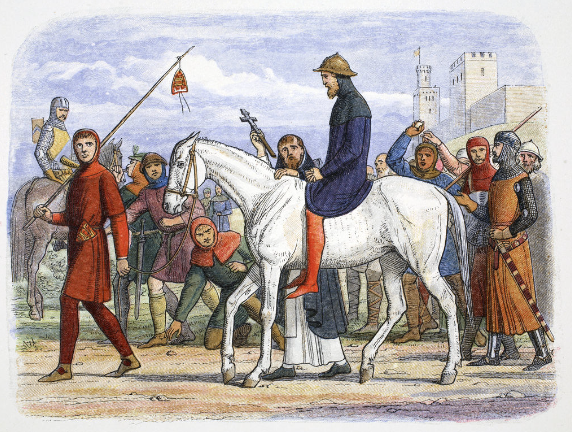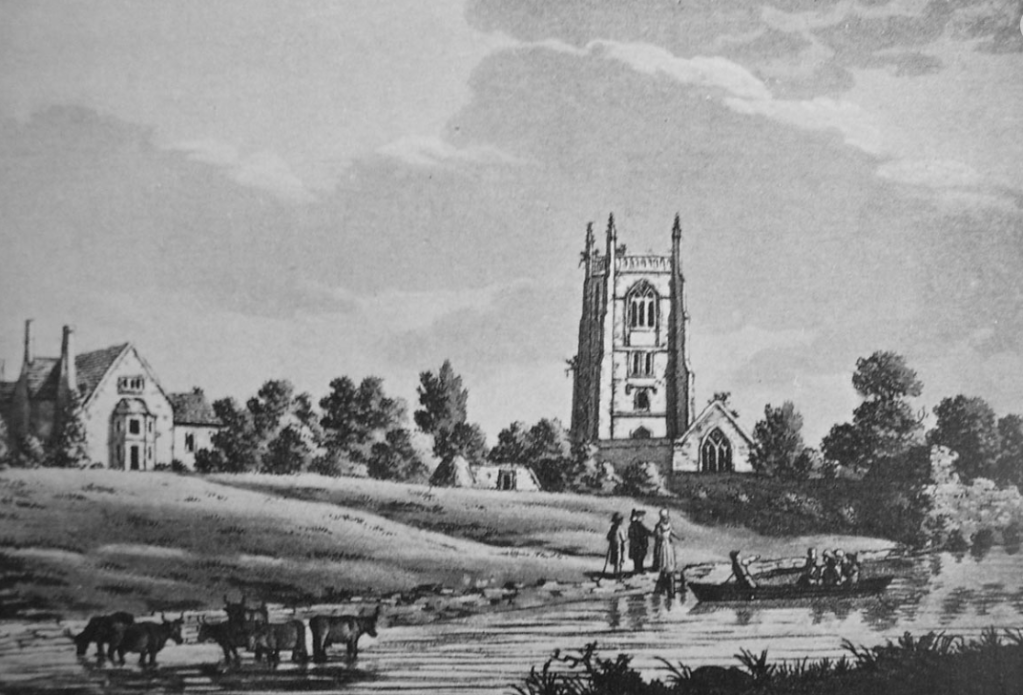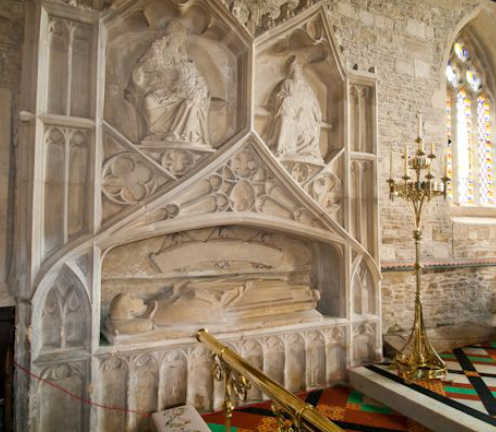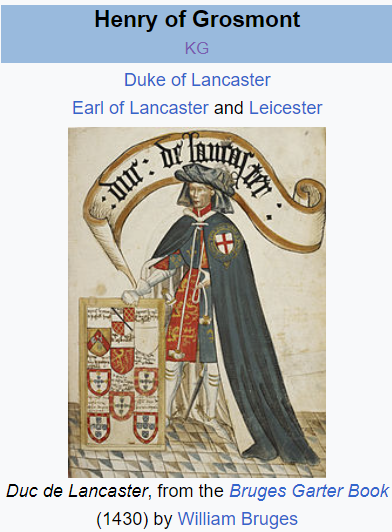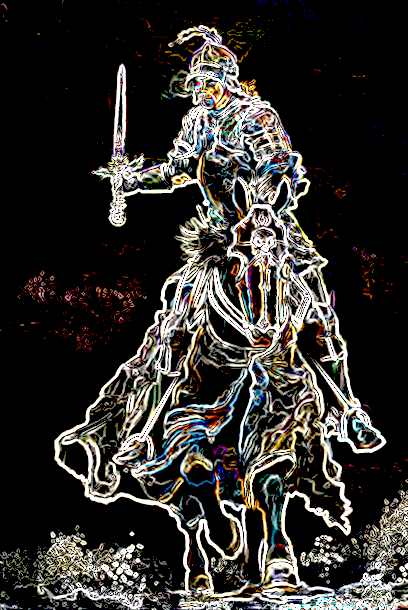Gloucestershire doesn’t lack ghostly stories, not least about the Wars of the Roses with, for example, Margaret of Anjou prowling the rooms of Owlpen Manor and the phantom messenger, on his way through Prestbury to Edward IV at Tewkesbury in May 1471 when he was killed by an arrow. He still gallops through the village at night, but whether or not he’s also a classic headless horseman I don’t know. Surely no self-respecting phantom rides around with its head in place, does it?
There are other ghostly stories dotted around the county, but today I will concentrate mainly on one. I found it in the deliciously informative pages of Folklore of Gloucestershire by Roy Palmer, which is a treasure trove of fascinating snippets about Gloucestershire’s past and present. This particular snippet relates events at Kempsford in Gloucestershire circa 1322 and seems to concern the wife of Thomas of Lancaster 2nd Earl of Lancaster (see here and here). He was a very high-ranking man, the grandson of King Henry III and cousin of King Edward II. Now, I say the story seems to attach to him because in the book the lead male character is Henry, 3rd Earl of Lancaster. But the only Earl of Lancaster who met a sticky end at Pontefract was Thomas.
After his death his many supporters agitated for him to be granted sainthood, but if the events related below are anything to go by there was another, far less worthy side to him. Oh, and as a matter of interest, he didn’t become St Thomas of Lancaster. There was a cult, of course, but the Pope was having none of him wearing a halo. Thomas put it about a bit, as the saying goes, and produced a number of illegitimate offspring. If he murdered his wife for her supposed infidelity he’d have been a very immoral Plantagenet pot accusing the innocent kettle black! Curiously, he left no legitimate children, and the cynic in me suspects the whole incident, if true, was a way of disposing of a wife he regarded as barren. After all, he knew he was potent enough!
Here is the story of events that preceded Thomas’s fate. There was great unrest in the realm during the reign of Edward II, and it culminated in the rise of the Lords Ordainer, of whom you can read here and here.
The 2nd Earl featured prominently among these rebels, and in his absence from Kempsford his wife, Lady Maud, played her part by receiving wounded rebels at Kempsford Castle to help nurse and then assist them to cross the deep River Thames, which lapped the foundations of the Earl’s residence. One of the rebels—a much sought-after fugitive—turned out to be her husband’s brother, and in the Earl’s absence she took the fugitive in and kept him hidden, for fear the king’s men could arrive and capture him. Or worse.
But there was another rebel knight she’d helped at Kempsford Castle (which was always a manor house as far as I can ascertain) and she had rebuffed his unwanted amorous advances. He was no gentleman, and as it happened he didn’t know the identity of the hidden man. Driven mad with jealousy, he sent word to the Earl, evidently an intemperate man, who returned in a fury and stormed into the hiding place to deal with Maud and her “lover”.
He knocked his brother down without recognising him and then seized the unfortunate Lady Maud and threw her from the ramparts into the waiting Thames, where she drowned. Too late did he learn the truth. He returned to the wars against Edward II, to be captured and executed at Pontefract Castle on 22 March 1322. Whether he was riddled with remorse isn’t recorded, but somehow I think not.
The jealous knight, overcome with guilt, became a penitent monk. He now lies beneath one of the monuments in Kempsford Church, but he doesn’t rest easy because his spirit haunts the Old Vicarage, which occupies part of the castle site.
Lady Maud’s wraith appears on the walk that bears her name in the Old Vicarage grounds. It was because of her that in the Second World War members of the Home Guard would only patrol the grounds in pairs. There are ghost hunters….and there are those who prefer not to encounter the supernatural.
So there you have the story as it appears in Folklore of Gloucestershire….and elsewhere, so I hasten to point out that it isn’t the fault of the book’s author, he’s merely recording the tale as it was known in the county. And as the death at Pontefract is mentioned specifically, and therefore indicates Thomas, I should point out first that he was not married to a Maud, but to Alice de Lacy, Countess of Lincoln – Wikipedia who turned up her highborn toes on 2 October 1348 at the grand old age of 66. This was more than twenty-six years after her husband, and when she went, it wasn’t into the waiting waters of the Thames at Kempsford.

Kempsford Castle is referred to in the story, but if there was ever a castle, there’s no trace of it now, nor is it mentioned at British History Online Kempsford | British History Online (british-history.ac.uk). There does, however, appear to have been a manor house which was connected to Thomas’s brother, Henry, 3rd Earl of Lancaster:-
“….The manor passed to Henry of Lancaster, (fn. 74) later earl of Lancaster, on his marriage to Maud de Chaworth [sole heiress of Chaworth family which had held Kempsford since the time of the Conquest] before 1297. Henry (d. 1345) was succeeded by his son Henry, created duke of Lancaster in 1351….”
Here we have our Maud! She was married to Henry, 3rd Earl of Lancaster. And guess what? He was Thomas’s brother! THE brother perchance? Had to be, if the tale is true, because a third brother, John, died earlier. After Pontefract Henry was the only one left. Anyway, Henry married Maud Chaworth. and they had seven children. In 1329/1330 he lost his sight and spent the rest of his life at Leicester Castle, eventually dying in 1345. Maud died on 3 December 1322 (aged 40). But, as stated above, Henry the 3rd Earl didn’t die at Pontefract, and Maud died after the Pontefract date too.
So, who, if anyone, was thrown into the Thames? Clearly not either of the above ladies.
But wait, there’s another tale told of the Thames at Kempsford, and it is to do with Henry and Maud’s son and heir, Henry of Grosmont, Duke of Lancaster, (actually the very first Duke of Lancaster) and was married to Isabel of Beaumont . The Duke was fabulously wealthy, but that was no protection from the plague, which saw them both off in 1361.
Anyone interested in English medieval history will know that Henry and Isabel had two daughters, one of whom was Blanche of Lancaster, the famous and beloved first wife of John of Gaunt. However, according to the folklore of Kempsford, there was also a son….who drowned in the Thames while still a child.
In his grief the duke left Kempsford and never returned, but his duchess, Isabel, remained and her spirit has lingered by the river ever since, still seeking her lost child.
Now, if you go here you’ll find another version of the story that’s sort-of different, but sort-of the same too. With the same conflation of lords and ladies. The drowning of the Duke of Lancaster’s little son is mentioned too, with the added information that when the anguished duke fled Kempsford his horse cast a shoe which is preserved outside the north door of the church. It seems a second horseshoe, with a second similar story, is displayed in the town of Lancaster.
So, ladies and gentlemen, the story told to Folklore of Gloucestershire is a conflation of three Lancastrian marriages, with a seasoning of mystery and murder stirred into the mix. Someone seems to have died in the Thames at Kempsford, but whether or not it was a little boy or a Countess of Lancaster is another matter.
Lastly I turn to another ghostly tale from Gloucestershire. To wit, the disappearing Yorkist messenger referred to at the beginning of this post. His presence had long been known in Prestbury, especially early on misty May mornings. Ghost hunters and thrill seekers have delighted in flocking to his supposed route, hoping for a shiversome glimpse. But I fear the ghostly horseman is meeting holy opposition, as you’ll read if you go here.
“….A spectral horseman on a brilliant white charger has been known to gallop along Shaw Green Lane in the early hours of misty spring mornings….He is thought to be the ghost of a messenger who, in 1471, was passing through the village en route to Edward IV’s camp at Tewkesbury, when he was shot dead by a Lancastrian archer. Interestingly, over the years, his phantom seems to be wasting away, since more recent sightings describe him as being little more than a dull glow….”
But no! The local clergyman is intent upon extinguishing him altogether! Please, no! We like our Gloucestershire phantoms. So save our spectral Yorkist messenger everyone, before he vanishes altogether!


